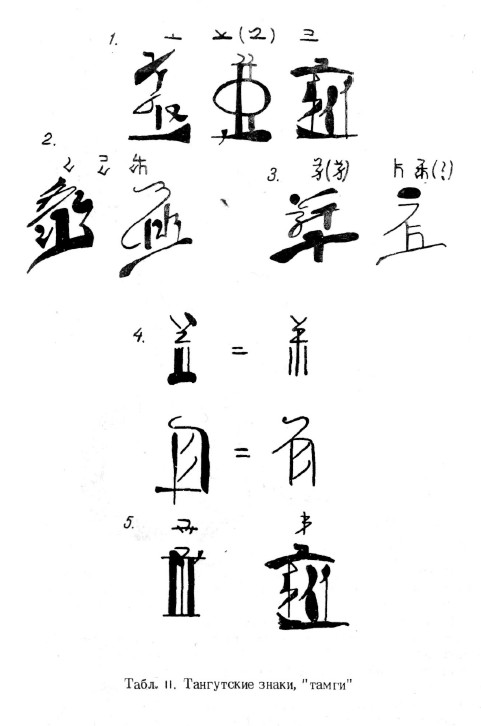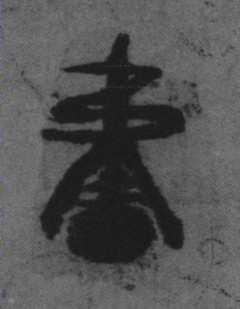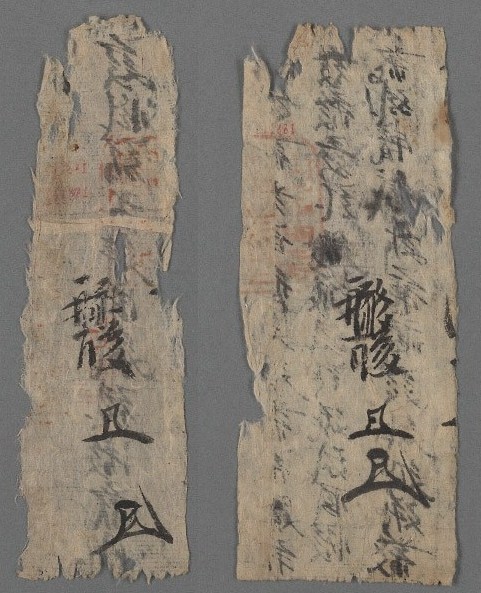BabelStone Blog
Saturday, 29 October 2011
Diligently Carved in Tangut
For the last of my impromptu trilogy of posts on manuscript fragments in extinct scripts that are freely available online thanks to the International Dunhuang Project I would like to take a look at an unprovenanced (but presumed to be from Dunhuang) manuscript of the Tangut translation of the Platform Sutra (六祖壇經) that is held at the Fu Ssu-nien Library at Academia Sinica in Taibei. This item comprises one large piece (13 lines of Tangut on one side and 11 lines of Tangut on the other) and four small fragments from a paper scroll, with the sutra text written in an untidy, semi-cursive hand. Actually, I have no particular interest in the Tangut text of the sutra, but I am puzzled by the writing on the back of two of the small fragments :
Two fragments of Academia Sinica 188119
The same two Tangut characters, meaning "diligently carved" (Chinese qínkè 勤刻)Note 1, are written on both fragments :
- 𗸐 (L1474/K2556) [·jɨr/·i̯ə̣] = "diligent" (Chinese 勤)
- 𗍶 (L1630/K3219) [dzjɨj/ndzi̯e] = "to carve" (Chinese 雕刻)
(Note: the normal word for "carve" in the context of carving woodblock texts is 𘐘 [ku̱] (L5217), although the compound word 𘐘𗍶 [ku̱ dzjɨj] is given for "to carve" in the Homophones.)
The words "diligently carved" are the sort of thing that might be expected to be written at the end of a printed text indicating who was responsible for carving the woodblocks ("diligently carved by X"), but these are handwritten, appear to be written in isolation, and are not preceded by a personal name. But the big question is what are the two symbols underneath the words "diligently carved" on both fragments ? The two symbols, which are similar to each other but clearly distinct, are constructed with the same sort of brushstrokes that are used for writing Tangut or Chinese, but they do not seem to be Tangut, Chinese or Khitan characters, or indeed characters from any script that I am familiar with. The fact that the same two Tangut characters and following two symbols are written twice suggests that the author was practicing writing them; and given that he appears to be already able to write Tangut fluently, it is most probable that he was practicing writing the two symbols. But why would anyone need to diligently carve these two symbols ?
My only guess is that they are some sort of magical symbols intended to be used as a talisman, and that perhaps the word "carve" is here used in an extended sense of "inscribe", meaning that the writer has diligently inscribed these magical symbols on the paper. Maybe these two scraps of paper were deliberately torn off an old sutra, and the two symbols inscribed on them as a form of talisman. But that is just speculation — if anyone recognises these symbols or has any better suggestions as to what they mean, then please let me know.
Addendum A [2011-10-31]
After reading this post, Viacheslav Zaytsev very kindly supplied me with the following book written by Anatoliy Pavlovich Terentiev-Katansky (1934–1998) :
- Терентьев-Катанский, А. П., Книжное дело в государстве тангутов (по материалам коллекции П. К. Козлова). Москва: Наука, 1981.
- 〔俄〕А.П.捷连提耶夫-卡坦斯基著,王克孝、景永时译,《西夏书籍业》。银川:宁夏人民出版社,2000年。
Viacheslav suggested to me that the two mystery symbols may be examples of tamgas — family or clan symbols used by Turkic and Mongolic peoples, used here to represent the name of the writer. This seems to me to be a very plausible theory, worth further investigation, but for now I will merely point out that Terentiev-Katansky's book gives a few examples of Tangut characters drawn stylistically as tamgas, including the character 𘍝 (L4743) [·iọ] meaning "round", which looks quite similar to the second mystery symbol (notice how the tamga form of L4743 has a little loop at the top, and the second mystery symbol has an oval blob at the top, which may be equivalent to the loop) :

Examples of Tangut tamgas from Terentiev-Katansky 1981 page 67
Actually, most of these examples of tamgas are not like traditional tamgas, which are generally a rather simple design (such as the trident tamga or crossed double-trident tamga), but are more like the stylized, cursive signature marks known as huāyā 花押 (Japanese kaō) that were popular during Tang, Song, Jin and Yuan dynasties. The following example of a Tangut huāyā or tamga was pointed out to me recently by Marc Miyake :

Examples of a Tangut huāyā or tamga in Wǔyīn Qiēyùn 五音切韻 [IOM No.623]
Last modified: 2017-01-01 (updated with Unicode Tangut characters)
If Tangut characters do not display correctly, please download and install the Tangut Yinchuan font.
Index of BabelStone Blog Posts
